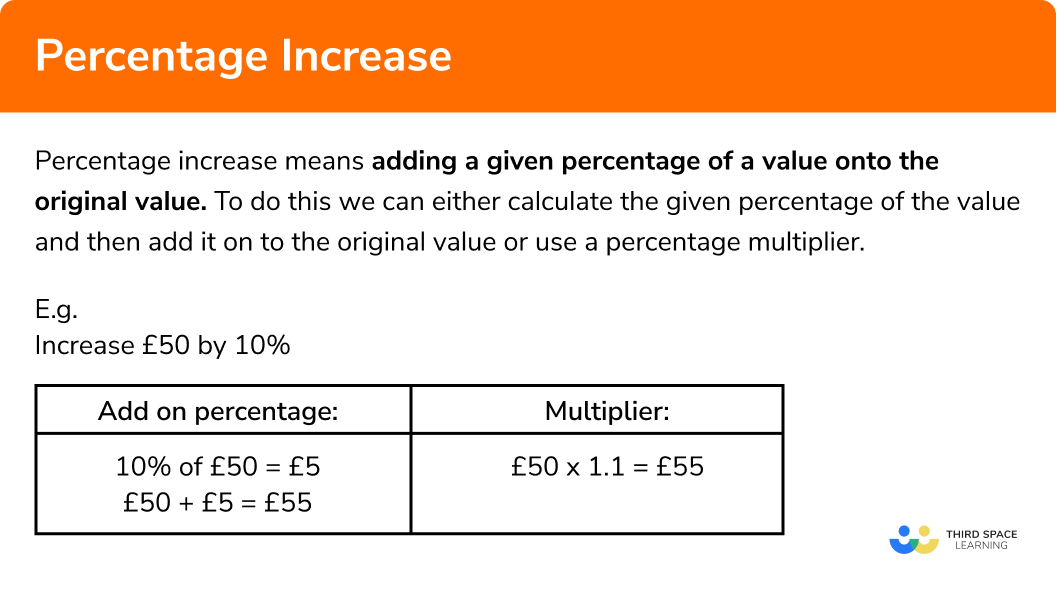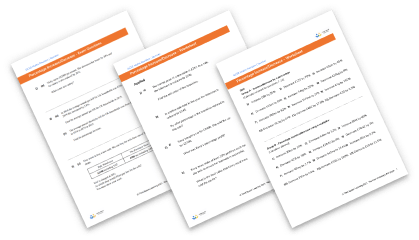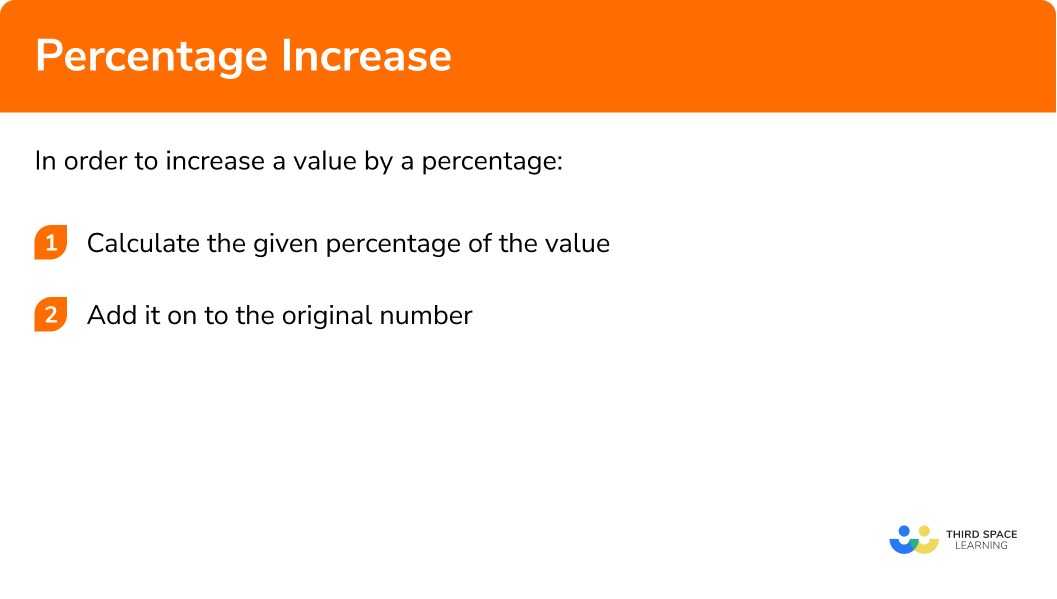One to one maths interventions built for KS4 success
Weekly online one to one GCSE maths revision lessons now available
This topic is relevant for:

Percentage Increase
Here is everything you need to know about percentage increase for GCSE maths (Edexcel, AQA and OCR). You’ll learn how to increase a value by a given percentage, use multipliers to calculate percentage increase and work out percentage change.
Look out for the percentage increase and decrease worksheets and exam questions at the end.
What is percentage increase?
Percentage increase means adding a given percentage of a value on to the original value. To do this we can either calculate the given percentage of the value and then add it on to the original value or use a percentage multiplier.
Explain what percentage increase is?


Percentage increase and decrease worksheet

Get your free percentage increase and decrease worksheet of 20+ questions and answers. Includes reasoning and applied questions.
DOWNLOAD FREE
Percentage increase and decrease worksheet

Get your free percentage increase and decrease worksheet of 20+ questions and answers. Includes reasoning and applied questions.
DOWNLOAD FREEHow to increase a value by a percentage
In order to increase a value by a percentage:
- Calculate the given percentage of the value.
- Add it on to the original number.
What are the 2 steps to increase a value by a percentage?

How to work out percentage increase examples
Example 1: non-calculator
Increase
- Calculate
40% of£50
To do this without a calculator, the easiest way is to calculate
2 Add
Example 2: non-calculator
Increase
Calculate 65% of 400
Add 260 on to the original value
Example 3: using a calculator
Increase
Calculate 27% of 350m
When using a calculator to calculate a percentage, we divide the value by
Add 94.5m on to the original value
Example 4: using a calculator
The price of Katrina’s train ticket last year was
Calculate 17.5% of £72
Add £12.60 on to the original value
How to increase a value by a percentage using a percentage multiplier
We can increase a value by a percentage using a percentage multiplier. A percentage multiplier is a decimal that is related to the percentage you are trying to find.
- Add the percentage we are increasing by to
100%
We add it on to
2Convert to a decimal
3Multiply the original amount by the decimal
Example 5: using a multiplier
Increase
Here we are calculating a 24 percent increase so add 24% on to 100%
Convert to a decimal. To do this we divide the percentage by 100.
Multiply 3200 by 1.24
Example 6: using a multiplier
In
This is a 12.5 percent increase so we add 12.5% on to 100%
Convert to a decimal.
Multiply £620 by 1.125
Remember to always write money using two decimal places.
How to calculate percentage increase between two values
Given two values, we can calculate the percentage change. This may also be called percentage difference, percentage increase, percentage gain or percentage profit.
We can calculate percentage change using the percentage change formula:
The same formula can be used to calculate percentage decrease
- Work out how much the value has changed by subtracting the old number from the new number.
- Apply the percentage change formula
Example 7: calculating percentage change
The weight of a lamb has increased from
The weight of the lamb has changed from 4kg to 5.2kg. Work out the actual change:
Apply the percentage change formula. The change is 1.2kg and the original amount is 4kg.
Percentage change
The lamb’s weight has increased by
Example 8: calculating percentage profit
Lucy buys an antique table for
Work out the change in value by subtracting the original price from the new price:
Apply the percentage change formula. The change is £35 and the original price is £150.
Percentage change
The percentage profit is
Common misconceptions
- Percentages greater than
100%
Believing that percentages cannot be greater than
- Converting between percentages and decimals
Incorrectly converting percentages to decimals. The most common mistakes are with single digit percentages (e.g.
Remember to divide the percentage by
E.g.
- Using an incorrect value for the denominator in the percentage increase formula
Using the new value instead of the original value for the denominator when calculating percentage change.
Related lessons
Percentage increase is part of our series of lessons to support revision on percentages. You may find it helpful to start with the main percentages lesson for a summary of what to expect, or use the step by step guides below for further detail on individual topics. Other lessons in this series include:
Percentage increase practice questions
1. Increase £520 by 20\% .
£540

£104

£624

£640

20\% of 520 is 104 . This can be added to the original amount to find the quantity after the increase.
2. Increase 3420m by 43\% .
3463m

4890.6m

1470.6m

3563m

43\% of 3420 is 1470.6 . This can be added to the original amount to find the quantity after the increase.
3. Use a multiplier to increase 38 by 14\% .
5.32

43.32

42

33.3

The multiplier we need to use is 1.14 , so the calculation is 1.14\times38 .
4. Use a multiplier to increase 650kg by 26.5\% .
172.25kg

822.25kg

513.83kg

676.5kg

The multiplier we need to use is 1.265 , so the calculation is 1.265\times650 .
5. Find the percentage increase when 400ml is increased to 620ml .
55\%

155\%

220\%

110\%

The amount has increased by 220ml . As a percentage of the original amount, this is \frac{220}{400}\times100 .
6. Find the percentage profit when Karam buys a house for £124000 and sells the house for £137640 .
111\%

89\%

11\%

136.4\%

The percentage profit is calculated as \frac{137640-124000}{124000}\times100 .
Percentage increase GCSE questions
1. (a) Catrin’s salary is £18000 . She receives a 3.5\% pay rise.
Work out Catrin’s new salary.
(b) How much extra money will Catrin earn each week?
(3 marks)
(a)
3.5\% of \pounds 18000 = \pounds 630
(1)
\pounds 18000 + \pounds 630 = \pounds 18630
(1)
(b)
\pounds 630 \div 52 = \pounds 12.12(1)
2. In 2010 the population of the UK was approximately 62220000 .
By 2020 it had increased to 66520000 .
Find the percentage increase in population over these 10 years.
Give your answer to 2dp .
(2 marks)
66520000 – 62220000 = 4300000
(1)
\frac{4300000}{62220000} \times 100=6.91\%
(1)
3. Thomas bought a box containing 100 packets of crisps for £30 .
He sold 96 packets of crisps for 50p each.
Calculate Thomas’s percentage profit.
(3 marks)
(1)
\pounds 48-\pounds 30=\pounds 18
(1)
\frac{18}{30} \times 100=60 \%
(1)
Learning checklist
You have now learned how to:
- Increase a value by a given percentage
- Use a percentage multiplier to increase a value by a percentage
- Calculate percent increase between two values
The next lessons are
Still stuck?
Prepare your KS4 students for maths GCSEs success with Third Space Learning. Weekly online one to one GCSE maths revision lessons delivered by expert maths tutors.

Find out more about our GCSE maths tuition programme.